Table of Contents
Cloud Shared Licensing
Like network floating licensing, cloud shared licensing allows multiple users to share licenses. For example, if you have 20 users but only a maximum of 5 of those 20 need to use the software at the same time, you may choose to purchase only 5 cloud shared licenses.
However, unlike network floating licensing, cloud shared licensing does not require you to select and install software on a server in your network to be a license server, nor does it require you to get a license file from CTC for that server. Further, it requires your users only have any kind of Internet connection, rather than having a connection to your internal network (e.g. over VPN) as they would in order to access your CTC license server on your network for network floating licensing. This can be particularly useful for remote users who do not need to be connected to your network sometimes in order to do their work.
The first time a user tries to use a cloud shared license, they may be asked to login to CTC’s cloud. They may not be asked to login if they are already logged in from another tool, such as CTC’s Nexus CMS product.

- Only the maximum number of licenses purchased for a software product can be checked out at the same time. When one extra user tries to run the software, they are informed that no licenses are available, and they will have to try to run the software again later after another user has closed all the tools for a product (suite) and the other user’s license is then checked back into the cloud license server.
- A user never uses up more than one license for a product while on a single computer. For example, if the user has Revit 2023 running and starts a premium tool that checks out a license for “BIM Project Suite” from the license server, and while that tool is running they start up another Revit session – even for a different version of Revit – and launch another premium tool from the same suite, *only 1 license will be considered in use by that user*. The license is not returned to the server until all instances of the tools from that suite have been shut down for all instances of Revit that are running on that computer.
- If the user leaves the tool running which has checked out a license and they go to another computer and start up another licensed tool for the same product, then another license will be checked out on that second computer, and the user will be consuming two licenses. So licenses are specific to the combination of user, computer and CTC product.
CTC provides the license management in CTC’s cloud, and you can manage your license usage from the CTC portal. For example, you control who is allowed to use each product (suite), you can see who is currently using licenses, and you can even revoke a non-borrowed license from a user. This can be useful if another user urgently needs a license. You can also see who has borrowed a license, and when that borrowed license will expire. This is explained in the next section.
Managing Cloud Shared Licenses
CTC Products can be managed in the CTC Software Customer Portal. All of the licenses owned by the organization will be listed under the ‘Licensing’ tab. A minimum role of either Organization Admin or License Admin must be assigned to anyone who will be managing licenses for the organization.
NOTE: Licenses will not be available to any of the organization users until they have been “assigned” in the portal. This does not include free tools in the product. Free tools will be always available, regardless of licensing.
*Users must configure their product on their workstation to use Cloud Shared Licensing before the licenses will be available to them. This can be done using the “Product and License Information” dialog, or by using configuration files (discussed below).*
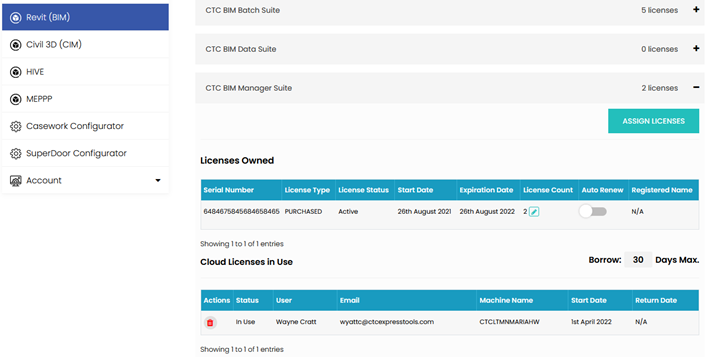
In the above example, this organization owns 5 seats of BIM Batch Suite and 2 seats of BIM Manager Suite. This means that at any given time, a maximum of 5 users can run a licensed tool from BIM Batch Suite simultaneously, regardless of how many users have been assigned beyond the count purchased. Likewise, only two can use BIM Manager Suite licensed tools at the same time.
This means that if 10 users have been assigned a BIM Batch Suite license, only 5 users can use licensed tools in the product at the same time. If a 6th simultaneous user attempts to use a licensed tool in BIM Batch Suite, they will be alerted that no license is available at that time.
Assigning Licenses to Groups and Users
Licenses can be assigned directly to a user account, or to a group. Assigning to groups may be a much easier to manage which users have access to which licenses.
To learn about creating and managing groups (recommended method), read the Guide on Groups and the Guide on Users.
Begin by expanding one of the product rows and clicking on ‘Assign Licenses:’
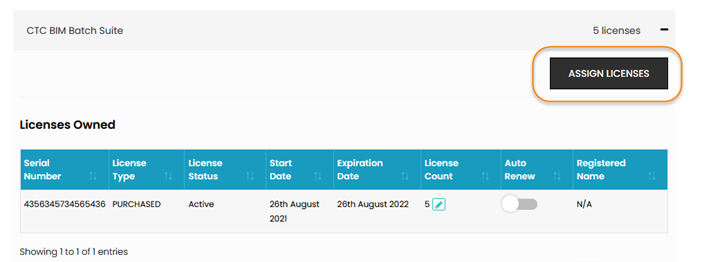
The Group and User selection form will present assignments that may have already been made in the list below the selector. This can also be used to remove assignments by clicking on the trashcan icon.

The first tab presents group assignments. The second tab presents user assignments. To add to the list of assignments, click in the selector and choose items from the selection list.

*Hint:* type the first few characters of a name to filter the list.
To remove a group or user during the add process from the temporary list, click the X on the right of the “pill.”
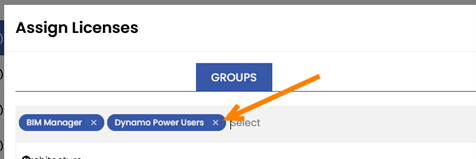
Once satisfied with the selections, click the SAVE button to update the assignments.
Controlling Borrow Duration
The maximum number of days that users may borrow a license can be adjusted for each product.
Use the slider to set the number of days.

Setting the number of days to zero will disable borrowing of licenses for this product.
When the user is presented with the day picker in the tools, they will only see the number of days to select that are specified here. If disabled, they will receive a message alerting them that borrowing is unavailable.
- The license will automatically be available again on the CTC cloud server even if the user who borrowed it doesn’t connect to the CTC cloud server after the period in which it was borrowed comes to an end. The license will also stop working on their computer after the period in which it was borrowed comes to an end, even if they don’t connect to the license server.
IMPORTANT: A borrowed license CAN NOT be forcibly returned to the CTC license pool. It will be automatically available on the CTC cloud server when the borrow time has expired, or when the user who borrowed it connects to the CTC cloud server and manually returns the borrowed license from their computer early.
Revoking a License
It may be necessary to temporarily force a checked out license that is currently in use on a workstation back into the pool. This can be used to ensure that a license is available to a user whose task may be urgent.
NOTE: Revoking a license will be effective immediately. The user will no longer be able to continue using paid tools until a license becomes available again. They will get a message telling them they no longer have a license. While they will not be able to continue doing useful things with the software, it should allow them to save their work, such as any settings they may have changed.
Expand the product row for the CTC suite to see the list of cloud licenses in use.
Find the user in question and click the trashcan icon.
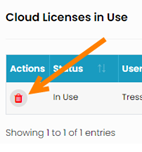
As stated previously, revoking a license does not apply to borrowed licenses.
Using a License
If your organization has set up access to cloud shared licensing, all that is needed to use the tools is to configure it and log in using a CTC Software user account.
Configuring the workstation tools can be done either by using a configuration file (discussed below) or by using the Product and License Information screen. This screen will appear the first time a paid tool is used, or can be accessed from within a tool using the Suite Licensing menu choice.
From any suite, choose Suite Settings

Or, in any tool, access licensing directly from the corner menu:

On the “Product and License Information” screen, select the Cloud Shared button.

Switching to Cloud Shared will prompt to log in to CTC Software (if not already logged in using another of the CTC tools)

Checking out a License
Once successfully logged in, the tool will connect to the online licensing engine, verify the user account has been allocated a license and return a success message.
This is called “Checking Out” and is entirely automatic. As long as there is a license available, it will be consumed whenever a tool that requires is used.
Borrowing a License
If a license is needed in anticipation of being disconnected from the Internet, borrowing a license can ensure that the CTC tools are available for use.
IMPORTANT: For normal use of the software, where you have a standard Internet connection, you DO NOT need to borrow a license. Borrowing a license is normally only needed when you know you will need to use the software at a time when you won’t have an Internet connection. While you have a license borrowed, that is one less shared license available to all other users.
NOTE: This only applies to CTC tools, a license may need to be borrowed for the Autodesk platform they are running on as well.
Begin by opening the Product and License Information screen. From here, click the ‘Borrow…’ button to the right of the Cloud Shared choice to begin the process of choosing the length of time to borrow a Cloud Shared license.
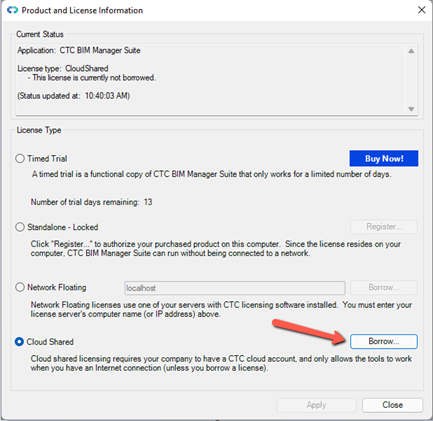
The date selector should appear showing the date and length of time allow by the organization administrator.

Confirm the date selection and click ‘Borrow License’. A success message should appear.

Return a Borrowed License
To return the license early, in the Product and License Information form, find the ‘Return Early…’ button and click it.
NOTE: In the event your computer is lost, stolen or damaged (e.g. a hard drive crash) an administrator CAN NOT recover a borrowed license. In that case, the license will be unavailable to all users until the borrow period has naturally expired. As such, you only want to borrow a license for the barest minimum amount of time needed.
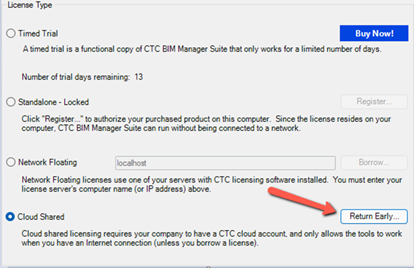
A prompt will appear confirming that the license should be returned.
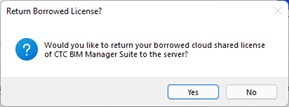
Click the Yes button, then you should see:
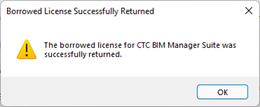
The license status should now show a ‘not borrowed’ message.
